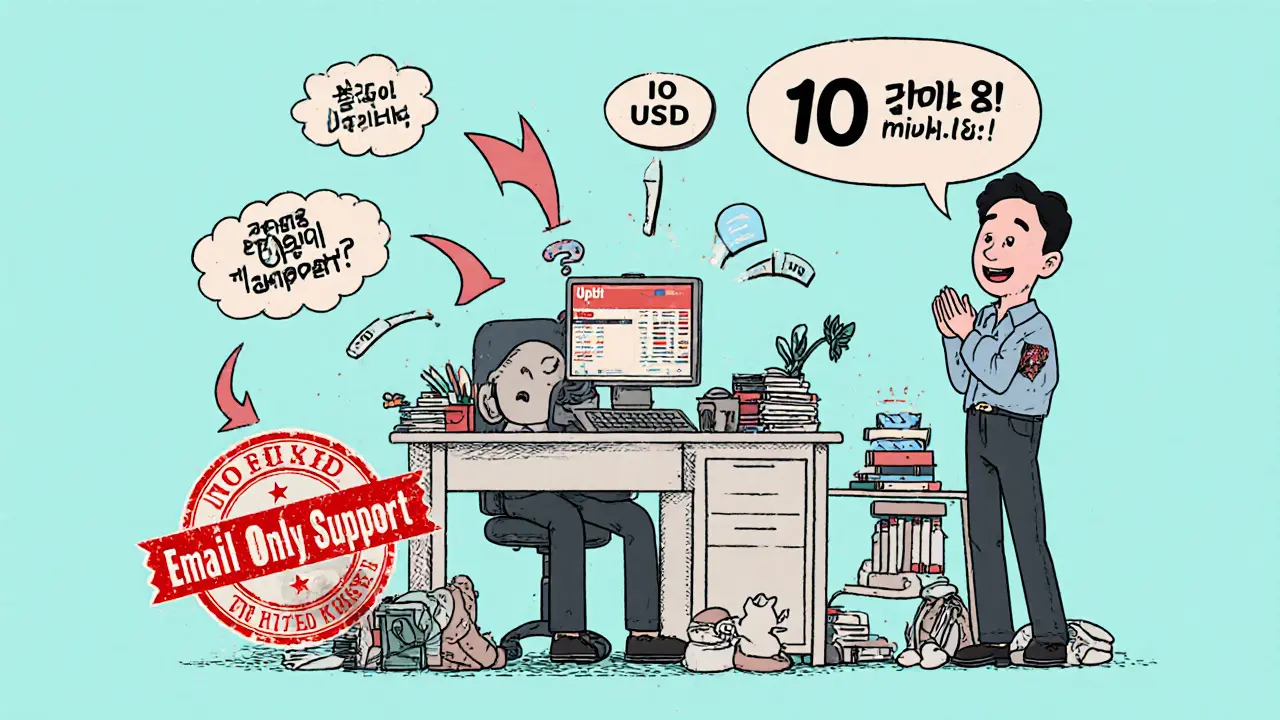Upbit Trading Fee Calculator
Fee Calculator
Results
Enter your trade details to see fee calculations.
Upbit Crypto Exchange Review 2025: Is It Right for You?
If you're looking for a crypto exchange that’s rock-solid on security and deeply tied to the Korean market, Upbit is one of the most reliable names out there. But if you’re outside Korea, want to trade futures, or need fast customer support in English, you’ll hit some serious roadblocks. This isn’t just another exchange review - it’s a clear-eyed look at what Upbit actually delivers in 2025, based on real user experiences, updated fees, and the latest regulatory changes.
Launched in 2017 by Dunamu (a Kakao subsidiary), Upbit grew to dominate South Korea’s crypto scene. Today, it handles over $300 million in daily trades and holds about 85% of the Korean market. But globally? It’s barely in the top 10. That’s not a flaw - it’s a strategy. Upbit isn’t trying to beat Binance. It’s trying to be the safest, most compliant place for Koreans to trade.
What You Can Trade on Upbit
Upbit supports over 180 cryptocurrencies, including Bitcoin, Ethereum, Solana, and major stablecoins like USDT and USDC. But here’s the catch: the list isn’t as broad as it sounds. Popular tokens like Avalanche (AVAX), Polygon (MATIC), and many memecoins are missing. In fact, Coin Bureau’s 2025 review pointed out that Upbit still doesn’t list some of the biggest DeFi and Layer 2 tokens that other exchanges added years ago.
Trading pairs are limited to KRW (Korean Won), BTC, and USDT. No USD pairs. No EUR. If you’re outside Korea, you’ll need to buy USDT or BTC on another exchange first, then transfer it to Upbit. That adds steps, fees, and risk. For Korean users, this isn’t an issue - KRW deposits hit their account in under 3 minutes. For everyone else? It’s a barrier.
Order types are basic: limit, market, and stop-limit. No margin trading. No futures. No leverage. Not even 2x. If you’re used to trading on Binance or Bybit, where you can go 125x on BTC, Upbit will feel like a museum piece. It’s spot-only, plain and simple. That’s intentional. South Korea’s financial regulators banned leveraged crypto trading in 2021, and Upbit followed suit - fully.
Fees and Trading Costs
Upbit’s fee structure is confusing because different sources report different numbers. TradingFinder’s 2025 data says 0.25% for KRW and SGD pairs, 0.2% for USDT/BTC. OneSafe claims 0.05% for KRW - but that’s likely outdated or misreported. The safest bet is to assume 0.2% to 0.25% for most trades.
That’s higher than Bybit (0.1%) or Kraken (0.16%), but lower than Coinbase (0.5%+). For Korean traders, the fee is worth it for the speed and safety. For international users? You’re paying more for less.
There are no fees for internal transfers between Upbit accounts. That’s a nice perk if you’re moving funds between your own wallets on the platform. But withdrawal fees vary by coin. Bitcoin withdrawals cost 0.0005 BTC. Ethereum is 0.005 ETH. These are standard, but not competitive.
Minimum trade sizes are strict. You can’t buy $1 of Bitcoin. The minimum is 0.0001 BTC (around $6 at current prices). For altcoins, it’s often higher - 0.1 ETH or 100 SOL. If you’re a small investor, this could be a problem.
Security: Where Upbit Shines
This is where Upbit earns its reputation. It stores 98% of user funds in cold storage. That’s among the highest in the industry. The rest is in hot wallets for trading, but even those are monitored by AI systems that flag suspicious activity in real time.
All withdrawals require two-factor authentication (2FA). You can’t move funds without it. Upbit also runs quarterly third-party security audits - Kudelski Security, a top firm trusted by banks, handles these. Their reports are public, and Upbit has maintained ISO 27001, ISO 27017, and ISO 27018 certifications since 2022. These are the same standards banks use.
CertiK gave Upbit an A-grade security score of 83.52 in early 2025, with a 92.40 operational resilience rating. That’s excellent. But CER.live gave it only a B (62/100), citing weak user security practices and no public penetration tests. That’s a red flag. If you’re a pro, you’ll want to dig into their security page and see if they’ve addressed this.
Upbit has never been hacked. Not once. In a space where exchanges like Mt. Gox, FTX, and KuCoin have fallen, that’s rare. And in Korea, where regulators demand proof-of-reserves, Upbit publishes quarterly audits. You can see every dollar they hold. That’s transparency most exchanges don’t offer.

KYC and Account Verification
Upbit’s KYC process is one of the strictest in the world. It has four levels:
- Level 1: Email verification. Lets you trade up to 500,000 KRW ($350) per day.
- Level 2: Upload your ID. Up to 5 million KRW ($3,500) daily.
- Level 3: Video call verification. Up to 50 million KRW ($35,000) daily.
- Level 4: In-person verification at a Korean branch. Up to 500 million KRW ($350,000) daily.
Most international users get stuck at Level 2. Level 3 and 4 require you to be physically in Korea. That’s a dealbreaker for anyone outside the country.
Verification time? 24 to 72 hours. Some users report waiting over 5 days. Reddit threads from March 2025 are full of complaints about frozen funds during verification. If you’re in a hurry, this isn’t the exchange for you.
Customer Support: A Major Weak Spot
Upbit’s support is split into two worlds: Korean and everything else.
Korean users get 24/7 live chat. Response times are under 10 minutes. It’s fast, helpful, and efficient.
For everyone else? Email only. Average response time: 18 hours. In English? Up to 48 hours. And the answers are often generic: “We’re reviewing your case.” No phone. No live chat. No WhatsApp. No Telegram.
On Trustpilot, 82% of negative reviews mention poor English support. On Reddit’s r/CryptoCritiques, users say they’ve waited weeks for answers on simple issues like forgotten passwords or delayed deposits. If you’re not fluent in Korean, you’re on your own.
The English documentation is poorly written and outdated. The Korean version? Rated 4.7/5 on Naver, South Korea’s top review site. That gap says everything.
Mobile App and Platform Experience
The Upbit app is clean, fast, and fully featured. iOS and Android versions are polished, with real-time charts, order tracking, and push notifications for price alerts. API access is available for developers - useful if you’re building bots or automated strategies.
But the interface is designed for Korean users. The default language is Korean. Switching to English changes the labels, but not the logic. Buttons are unlabeled in English. Charts lack tooltips. The learning curve is steeper than it should be.
There’s no staking dashboard. No crypto card. No Earn program. No copy trading. No NFT marketplace. Upbit is a trading platform - nothing more. If you want to earn interest on your crypto, you’ll need another app.

Who Should Use Upbit?
Upbit is perfect for:
- Korean residents who want a safe, regulated place to trade crypto.
- Traders who prioritize security over features.
- People who need fast KRW deposits and withdrawals.
- Investors who want to avoid leverage and speculative trading.
Upbit is NOT for:
- International users who need USD pairs or easy deposits.
- Traders who want futures, leverage, or margin.
- Anyone who needs fast, responsive customer support in English.
- Small investors who want to buy $10 worth of crypto.
The Bottom Line
Upbit isn’t the biggest exchange. It’s not the flashiest. But in South Korea, it’s the most trusted. It’s the exchange Koreans use because they know their money is safe. The regulatory compliance, the cold storage, the audits - it’s all top-tier.
But if you’re not in Korea, or you need advanced trading tools, you’re better off with Binance, Kraken, or Bybit. Upbit doesn’t cater to you. It doesn’t try to. And that’s okay - as long as you know what you’re getting into.
For Korean users: Upbit is the gold standard. For everyone else: look elsewhere.
Is Upbit safe to use?
Yes, Upbit is one of the safest crypto exchanges in the world. It stores 98% of user funds in cold storage, requires two-factor authentication for all withdrawals, and undergoes quarterly security audits by Kudelski Security. It holds ISO 27001, ISO 27017, and ISO 27018 certifications - the same standards used by major banks. It has never been hacked.
Can I use Upbit outside of South Korea?
You can create an account from anywhere, but your options are limited. Upbit only supports KRW deposits for users in South Korea. International users can trade using BTC or USDT, but they can’t deposit or withdraw fiat currency directly. Also, customer support in English is slow and limited to email.
Does Upbit offer margin or futures trading?
No. Upbit only offers spot trading. It does not support margin, leverage, or futures contracts. This is due to South Korean regulations, which banned leveraged crypto trading in 2021. If you want to trade with leverage, you’ll need to use another exchange like Binance or Bybit.
How long does Upbit verification take?
Verification typically takes 24 to 72 hours. Some users report delays of up to 5 days, especially during high-volume periods. Level 4 verification (the highest) requires an in-person visit to a Korean branch, which is impossible for most international users.
What are Upbit’s trading fees?
Trading fees are generally 0.2% to 0.25%, depending on the pair. KRW and SGD pairs are charged at 0.25%, while USDT/BTC pairs are 0.2%. These are higher than competitors like Bybit (0.1%) but lower than Coinbase. There are no fees for internal transfers between Upbit accounts.
Does Upbit have a mobile app?
Yes, Upbit has official iOS and Android apps with full trading functionality. The apps support limit and market orders, price alerts, and API access. However, the interface is optimized for Korean users, and the English version is poorly translated, making it harder to navigate for non-Korean speakers.
Why are there so many negative reviews about Upbit?
Most negative reviews come from international users who face slow English support, long verification times, and frozen funds during market volatility. Trustpilot shows a 3.1/5 rating, with 39% of reviews being negative. The biggest complaints are about customer service delays and lack of features like staking or crypto cards.
Can I stake crypto on Upbit?
Upbit offers limited staking services for a few major coins like Ethereum and Solana, but it’s not a core feature. There’s no dedicated staking dashboard, and the rewards are modest compared to platforms like Coinbase or Kraken. Most users looking for yield stick to other exchanges.
Next Steps
If you’re in South Korea and want a secure, regulated place to trade crypto, Upbit is your best option. Sign up, complete Level 2 KYC, and start trading KRW pairs.
If you’re outside Korea and need USD support, futures, or fast support - skip Upbit. Use Binance, Kraken, or Bybit instead. They’re built for global users.
Don’t force yourself into a platform that doesn’t fit your needs. Upbit is excellent - but only for the right person.

